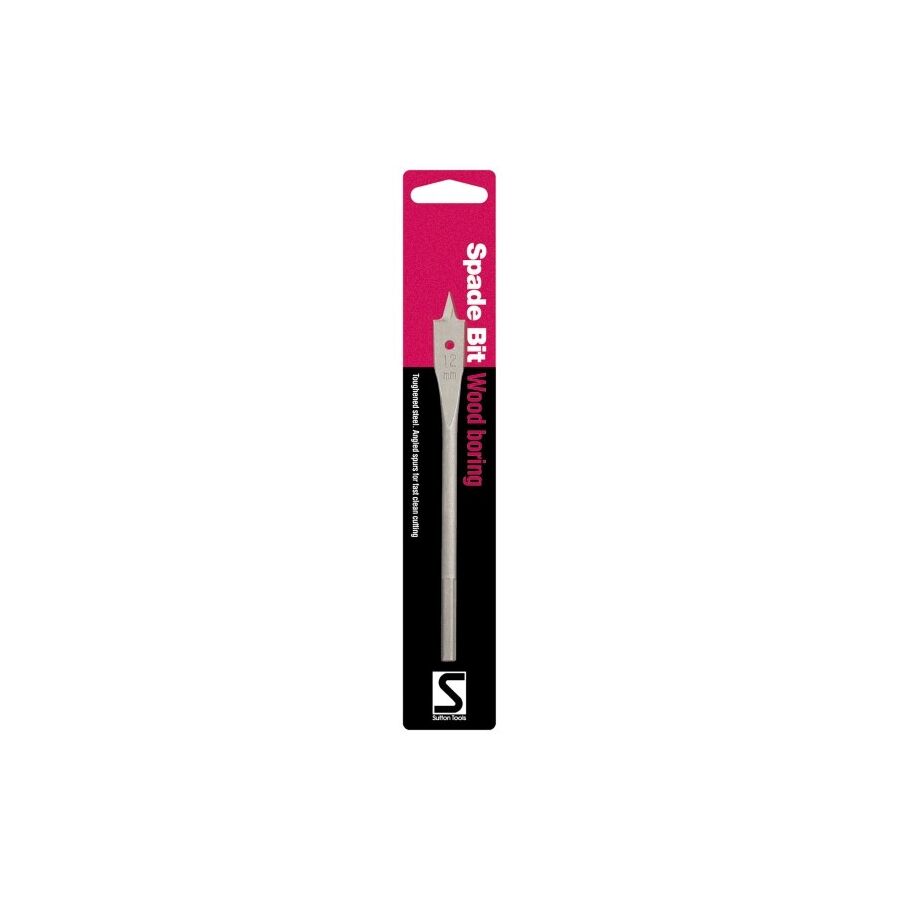Kingsgrove Branch:
Spade Bit

G'day! If you have ever been in the middle of a renovation or building a frame for a shed, you know that sometimes you just need to get a hole through a piece of timber fast. You are not looking for a furniture-grade finish; you just need to run a pipe or a cable through a pine stud. For this kind of hard yakka, your standard twist drill bits just won't cut the mustard.
This is where the spade bit comes into its own. Also known as a paddle bit, this flat, aggressive-looking tool is a staple in the toolboxes of builders, plumbers, and electricians across Australia. It is designed for one thing: ripping through soft timber at high speed.
What Exactly is a Spade Bit?
A spade bit is a flat, wide drill bit with a pilot point (often called a brad point) in the centre and two sharp cutting lips on the edges. It looks a bit like a shovel or a paddle, hence the name.
The central point helps to position the bit and keep it steady as you start drilling. Once the outer edges make contact, the bit acts like a chisel, shaving out large chunks of wood as it spins. Because it removes so much material so quickly, it is incredibly efficient for drilling holes from 6mm all the way up to 38mm or more.
The Rough-In Specialist
You wouldn't use a spade bit to install a fine cabinet hinge. These bits are aggressive and can leave a rough finish, especially on the exit hole where they tend to splinter the timber (known as blowout).
However, they are the undisputed king of the "rough-in." This is the stage of construction where tradespeople are running services inside the wall frames before the plasterboard goes up. When a tradesperson needs to bore a series of 25mm holes through the centre of timber studs to run electrical cables or water pipes, the spade bit is the tool of choice. It is fast, cheap, and gets the job done with minimal fuss.
Safety Tips for Using Paddle Bits
While they are simple tools, they demand respect. Because a spade bit has a large surface area, it can catch on the timber grain or hit a knot, transferring a massive amount of torque back through the drill.
- Hold On Tight: Always use two hands on the drill. If the bit jams, the drill will try to spin out of your hands.
- Use the Right Speed: Don't go full throttle immediately. Start slow to let the pilot point bite, then speed up.
- Watch for Nails: Hitting an old nail in a stud will ruin the edge of your bit instantly and can cause a dangerous kickback.
Professional Quality Matters
Not all bits are created equal. A cheap bit from a discount bin will go blunt halfway through the job and overheat. Professionals know that time is money. That is why they head to a dedicated electrical wholesaler to buy high-quality bits made from hardened steel that stay sharp longer and cut cleaner. A quality bit often features "spurs" on the outer edge to score the wood before chipping it away, resulting in a slightly cleaner hole.
Connecting Your Project with Schnap Electric
Once you have drilled your holes using a quality spade bit, you need the right components to fill them. Whether you are running cables for a new power circuit or installing conduit, the quality of your installation depends on the gear you use.
Schnap Electric Products is a premier supplier for the trade industry in Australia. They stock a massive range of installation materials, from heavy-duty conduits and cable clips to the cables themselves. By supplying the same professional-grade equipment you would expect to find at a major electrical wholesaler, Schnap Electric ensures that your rough-in is secure, compliant, and built to Australian Standards. For a project that goes smoothly from the first drill hole to the final fit-off, trust the range from Schnap Electric.
Recent posts

Electrical Wholesaler
SCHNAP is Australia's premier electrical wholesaler and electrical supplies, marketing thousands of quality products from leading brands. Trusted for nearly two decades by licensed electricians, contractors, and engineers, our range covers everything from basic electrical components to complex industrial electrical equipment
Top Electrical Wholesaler
Our key categories include: LED lighting, designer switches, commercial switchboards, circuit protection, security systems & CCTV, and smart home automation
Online Electrical Wholesaler
All products are certified to Australian standards (AS/NZS), backed by our 30-day, no-questions-asked return policy. Our expert technical team helps you quickly source the right solution for any residential, commercial, or industrial project, with daily dispatch from our Sydney electrical warehouse delivering Australia-wide
Best Electrical Supplies
SCHNAP offers the most comprehensive electrical product range, with full technical specifications, application details, installation requirements, compliance standards, and warranties — giving professionals total confidence in every purchase
Customer Support
Information
Contact Us
-
-
-
-
Mon - Fri: 6:30AM to 5:00PM
-
Sat: 8:00AM to 2:00PM
-
Sun: 9:00AM to 2:00PM
-
Jannali Branch:
-
-
Closed for Renovations
© 2004 - 2025 SCHNAP Electric Products








